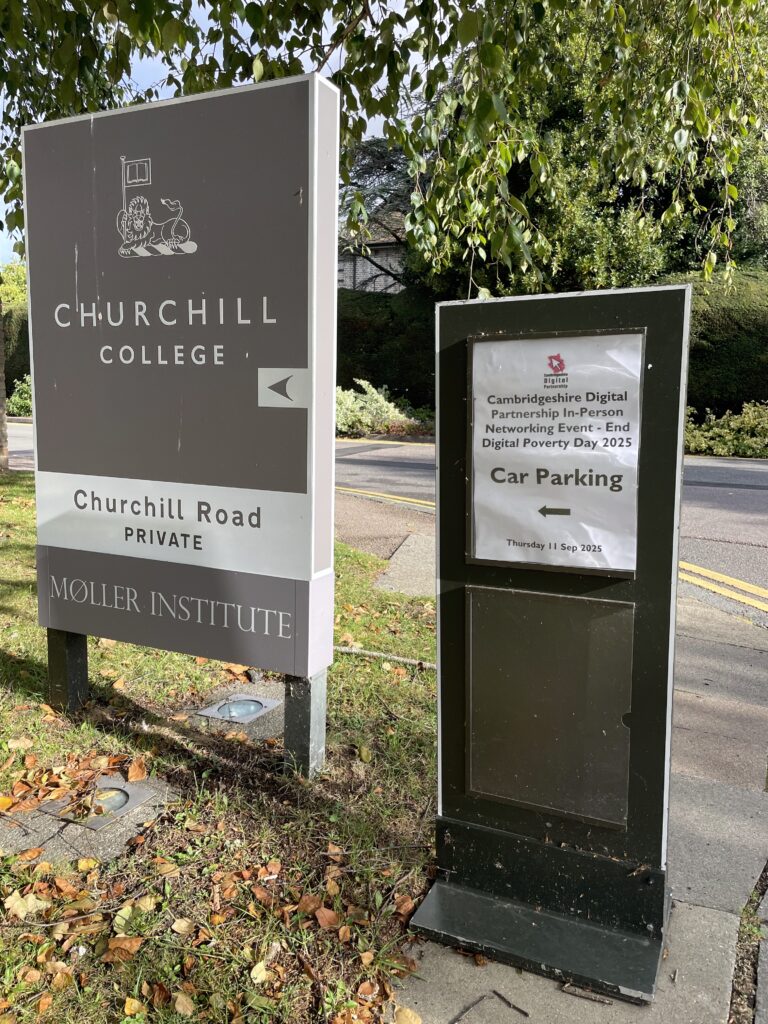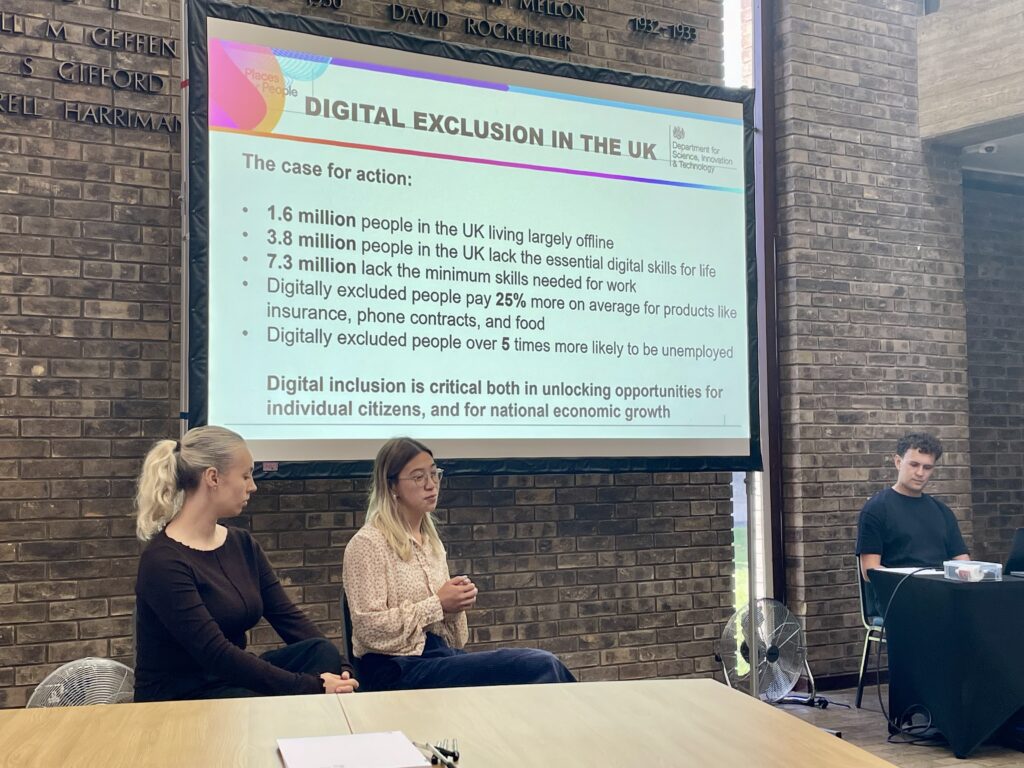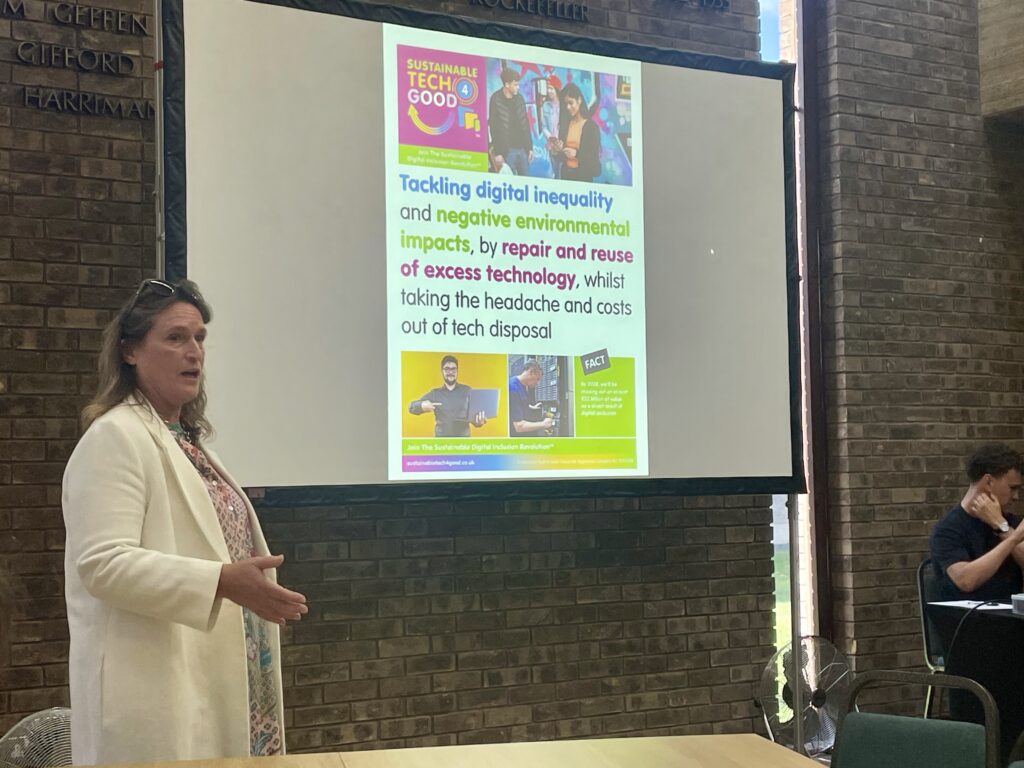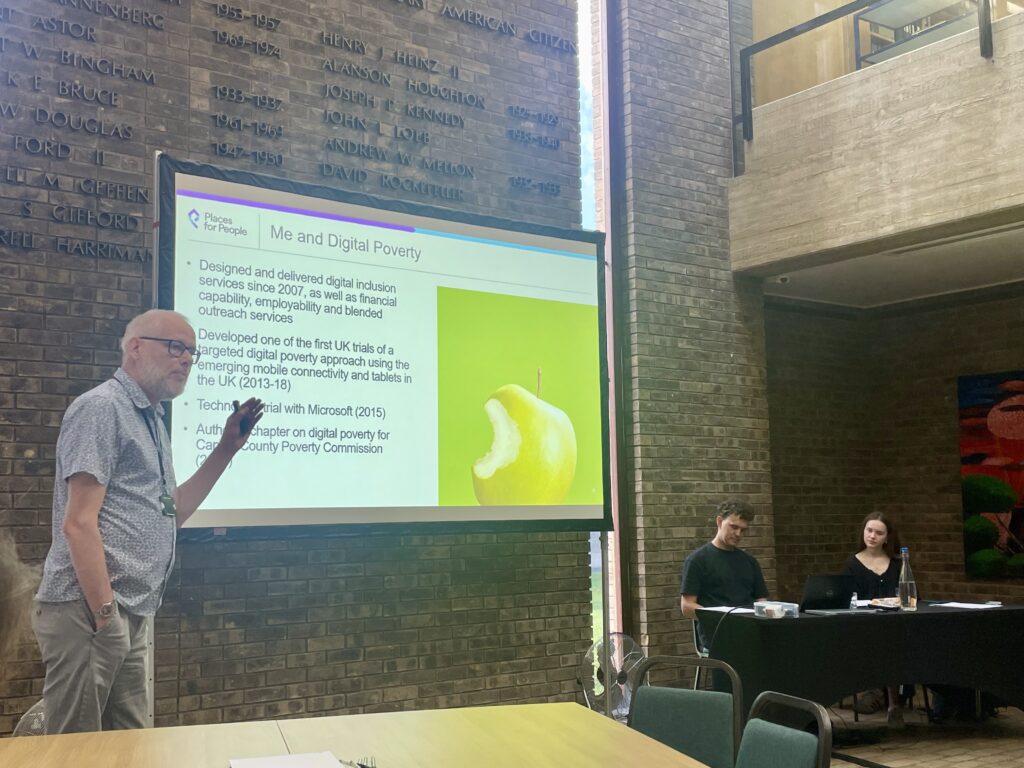Cambridgeshire Digital Partnership in-person event to mark End Digital Poverty Day 2025

We were thrilled to co-deliver this inspiring event with Connecting Cambridgeshire, set in the beautiful grounds of Churchill College on Thursday 11 September.
The morning brought together passionate voices and changemakers working to tackle digital poverty and promote digital inclusion across Cambridgeshire.
To begin, we had Will Plant, Digital Inclusion Lead at Connecting Cambridgeshire; Sarah Marsh, Programme Director and Head of Digital Connectivity at Connecting Cambridgeshire; and Sally Page, Deputy CEO at CCVS, who welcomed guests and introduced the work of Connecting Cambridgeshire and the Cambridgeshire Digital Partnership.

We were lucky to then introduce incredible guest speakers:

- Christine Liang, Head of the Digital Inclusion Programme, and Tash Crapnell, Head of Local Delivery and Confidence at the Department for Science, Innovation and Technology (DSIT)
- Sue Gowling, Founder of Sustainable Tech4Good
- James Lewis, Community Connector for Places for People and Trustee of The Angels Foundation UK
Christine and Tash, from DSIT’s Digital Inclusion & Skills Unit, made a compelling case for action, highlighting that:

- 1.6 million people in the UK live largely offline
- 3.8 million lack essential digital skills for life
- 7.3 million lack the minimum digital skills needed for work
- Digitally excluded people pay 25% more on average for essentials like insurance and food
- They are 5 times more likely to be unemployed
They outlined the government’s Digital Inclusion Action Plan, which aims to open up opportunities through skills development, tackle data and device poverty, break down barriers to digital services, and build digital confidence. Their focus includes low-income households, older people, disabled people, the unemployed, and young people. They also shared updates on the Digital Inclusion Innovation Fund, the IT Reuse for Good Charter, and partnerships with tech companies like Google and Virgin to improve access to skills and devices.

Next, Sue shared the impactful work of Sustainable Tech4Good, which has been tackling digital inequality and environmental waste since 2020. Their model securely collects, audits, repairs, and redistributes unused tech, helping people get online while reducing e-waste.
In Cambridgeshire alone, they’ve:
- Helped 1,585 people access devices
- Saved 2,282 kg of electronic waste from landfill
- Supported 50 local charities with digital inclusion programmes
Finally, James gave a powerful talk on the scale of digital poverty locally.
He shared that:
- Around 10,000 households in Cambridgeshire are digitally excluded
- 30% of affordable housing residents lack home broadband
- Those without broadband are 3 times more likely to go without essentials
- Many are unaware of social tariffs, missing out on potential savings of up to £1,000 per year
- Some rural residents spend £30 per week on transport for shopping—costs that could be avoided with online access

James called for embedding digital advice into frontline services and working with community partners to deliver sustainable digital inclusion—not just access, but empowerment.
His message was clear: digital inclusion is not a luxury—it’s a lifeline.
Roundtable discussions
Thank you to Sophie Skrimshire from Connecting Cambridgeshire for summarising the discussions.

Our attendees took part in lively and collaborative roundtable discussions exploring how we can strengthen digital inclusion across Cambridgeshire. It was inspiring to hear about the great work already happening—from libraries and housing providers to grassroots community groups—and to explore how we can close gaps in skills, support and access.
Conversations focused on practical ways of closing the gaps in our digital inclusion efforts and ways we could better align with broader poverty reduction efforts in Cambridgeshire. Some of the key discussions included:
- The importance of in-person support and skills development
- Recognising the importance for a needs-led, person-centred approach which tailors support to individuals’ needs
- How to strengthen knowledge and resource sharing across the county, including the development of a ‘living directory’ which maps digital inclusion efforts in Cambridgeshire
- Considering how we might build sustainable support models, thinking about:
- Volunteer capacity building
- Intergenerational work
- Partnerships with businesses
- Thinking critically about how we promote our efforts to those who are digitally excluded
- Reframing our language to better engage the community
- Understanding that digital exclusion isn’t a fixed state – it’s a shifting challenge which evolves with technology and individual needs. Staying confident and connected over time requires continuous learning and support.
It was a delight to see so many engaging conversations and meaningful connections forming throughout the morning, all accompanied by delicious coffee and pastries.
We’re incredibly grateful to all our speakers and attendees for making this event such a success. Together, we’re building a more connected, inclusive, and empowered Cambridgeshire.

Let’s keep connected and continue to fix the digital divide. Please take a look at our upcoming events, sign up to our newsletter or follow us on LinkedIn.
Thank you.
Please find below detailed notes from the discussions.
Existing Good Practice in Cambridgeshire
- Community Support: Red Hen Project, Cambridgeshire Skills, Citizens Advice, Cambridgeshire Online, Housing groups inc. Clarion Housing, Libraries, Repair Cafes, St Ives Cares
- Digital Skills & Devices: Digital Buddies, Learn My Way, Device My Way, National Databank, Sustainable Tech for Good.
- Connectivity: Connecting Cambridgeshire, Places for People.
- Networks & Partnerships: Cambridgeshire Digital Partnership, Digital Poverty Alliance, Cambridgeshire ACRE.
- Banks: NatWest, Lloyds, Barclays (Digital Eagles)
Combatting digital poverty by providing access to devices:
- Resources and support should be given alongside devices to provide confidence and skills
- Use picture-based booklets to support learning
- Link in with repair cafes
- Engage with trusted, local organisations and strengthen signposting
- Call for more ongoing, sustainable support – such as the work Cambridgeshire Online do
How could Connecting Cambridgeshire and the Cambridgeshire Digital Partnership support you to deliver digital inclusion?
- Teaching & Training: Help build digital skills through workshops. To include digital literacy: improve safety online for young people, promote scam awareness, address literacy-health barriers and offer tailored support for vulnerable users.
- Capacity Building: Assist with recruiting, retaining and upskilling volunteers. Focus on roles in connecting resources and coordinating efforts. Consider how to build sustainable support models i.e. intergenerational work. Support offering meaningful work experience through partnerships with businesses.
- Promotion: Increase public awareness and visibility through pop-ups and support engaging with local news and printed press
- Funding Collaboration: Partnering on joint bids and applications
- Knowledge Sharing: Facilitate cross-organisational learning and best practice exchange.
- Accessibility Standards: Co-develop simple, inclusive digital service guidelines.
- Living Directory: Create and maintain a map of digital inclusion efforts in Cambridgeshire
- Contract & Finance Guidance: Offer advice to small organisations on managing digital projects.
How can we better align digital inclusion with the Cambridgeshire Poverty Strategy commission findings?
- Understand the challenges
- Volunteers are vital, but capacity is limited. There’s a need to invest in upskilling and training.
- Current broadband social tariffs aren’t fit for purpose; they’re often inaccessible due to poor promotion, credit check requirements and slow speeds
- Quick wins need to be more person-centred – the projects we deliver should be needs-led
- Build trust with residents and improve our signposting in Cambridgeshire
- Need for an easy read version of the report, if there isn’t one
What more could be in done in Cambridgeshire to end digital poverty?
Gaps in Cambridgeshire
- Skills gap: Many initiatives assume a baseline digital literacy that doesn’t exist for all (e.g. illiteracy, older adults).
- Support gap: Funding often covers devices/connectivity, but not face-to-face help.
- Trust gap: People may distrust digital services, especially when linked to financial decisions.
- Coordination gap: There’s no central directory of digital inclusion efforts—suggested that a H.A.Y. for digital inclusion is created
What could we do?
- Improve communication methods: How can we best connect with people in digital poverty?
- Make sure information isn’t just available online e.g. physical leaflets posted through doors
- Access through family / friends
- Hyperlocal promotion – Make use of place-based work in Adult Social Care (Care Together at Cambridgeshire County Council) and explore the upcoming NHS Integrated Neighbourhoods
- Engage community champions and expert
- Address skills and learning challenges
- Being ‘digitally included’ is not a fixed state. Offer continuous learning and ongoing support as technology evolves.
- Different people need different devices and skills. Avoid a one-size-fits-all approach and instead, match tech and training to individual needs.
- Offer more opportunities for informal learning, with safe and low-pressure environments for skills building
- Reframe our Language
- Build trust by using plain, relatable language – ‘digital inclusion’ might not be the best term
- Understand and address why some people might be resistant to digital inclusion efforts
- Improve coordination
- Create a live, accessible directory of services, hubs and support
Good practice elsewhere:
- Navigator roles: Person-centred support guiding people through digital systems, support services etc. at a handover level – rather than just signposting.
- AI tools: Could local AI tools be used to guide residents using Cambridgeshire-specific databases? Retapp for instance match donated tech with recipients using AI.
- Global models: Human-first approaches that are less ‘tech-centric’ are more common outside of the UK. How could we learn from this?
September 2025